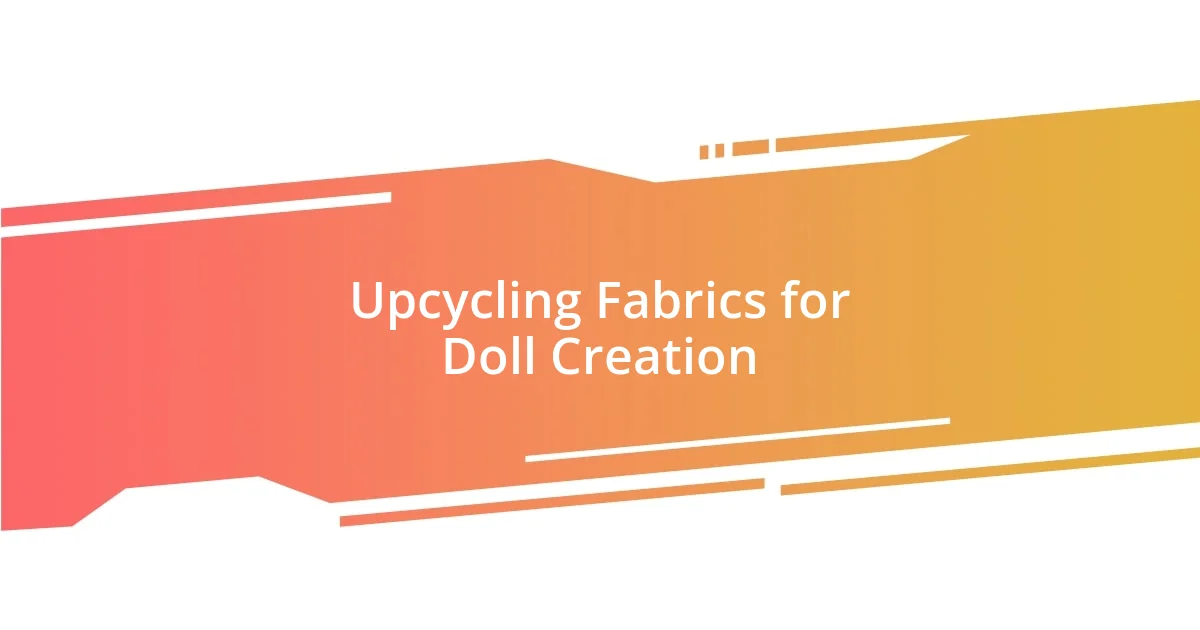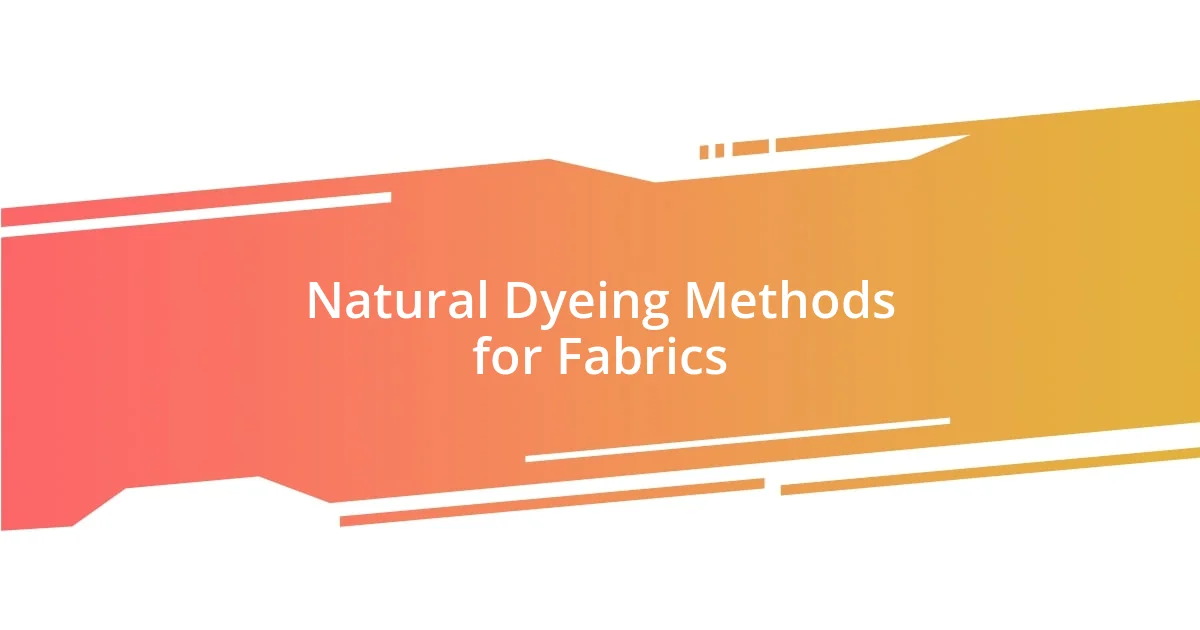Key takeaways:
- Sustainable doll making focuses on using natural, non-toxic materials and eco-friendly practices that contribute to environmental health.
- Upcycling fabrics and utilizing natural dyeing methods enhance creativity and reduce waste, adding sentimental value to each creation.
- Proper care for sustainable dolls, including gentle cleaning and appropriate storage, is essential to prolong their life and maintain their integrity.

Understanding Sustainable Doll Making
Sustainable doll making is about more than just crafting; it’s a journey towards mindfulness and environmental stewardship. I remember my first attempted creation using repurposed materials, and it felt deeply satisfying to transform discarded fabric into something meaningful. Isn’t it wonderful to think about how our choices can contribute to a healthier planet?
When we consider sustainable practices in doll making, it involves using natural, non-toxic materials that are safe for children and kind to the earth. For instance, I’ve found that organic cotton and eco-friendly dyes not only enhance the doll’s charm but also provide peace of mind to parents. Have you ever held a doll made with care and intention? There’s an unmistakable warmth that radiates from these lovingly crafted pieces.
Additionally, sustainable doll making emphasizes the importance of the processes involved, such as reduced waste and energy-efficient techniques. Recently, I experimented with a local artist who uses solar power in her workshop. It was eye-opening to see how small changes can lead to significant impacts, reminding me that every step counts in our journey toward sustainability. How can we all share this commitment to a greener future through our crafts?

Materials for Eco-Friendly Dolls
When it comes to materials for eco-friendly dolls, natural fibers like organic cotton and linen are my top picks. I remember the first time I used a beautifully soft, organic cotton for a doll I was making; the texture felt just right, and I could truly appreciate the difference it made in the overall aesthetic. It also resonated with me that these materials are biodegradable, which makes them a guilt-free choice for our planet.
Another fascinating option is wool, particularly when sourced from sustainable farms that practice humane grazing. When I crafted a doll using recycled wool remnants, the colors were surprisingly vibrant and full of personality. Plus, I felt good knowing that this approach not only minimizes waste but also supports ethical farming practices. There’s something incredibly rewarding about knowing the story behind the materials I use.
Lastly, I’ve come across bamboo fabric, which I’ve found to be incredibly versatile and soft. It’s a renewable resource that grows quickly, making it an excellent choice for environmentally conscious creators. Using bamboo felt like a refreshing twist in my doll-making journey, as its natural properties also ensure that the dolls are safe for little hands. Have you ever experienced the joy of creating something that aligns with your values? These materials not only tell a story but also bring a sense of fulfillment with each stitch.
| Material | Characteristics |
|---|---|
| Organic Cotton | Soft, biodegradable, and non-toxic. |
| Wool | Durable, vibrant colors, and supports sustainable farming. |
| Bamboo Fabric | Fast-growing, versatile, and safe for children. |

Upcycling Fabrics for Doll Creation
Upcycling fabrics for doll creation has become one of my favorite techniques, not just for its environmental benefits, but also for the creative joy it brings. I vividly recall scavenging through my old clothing bins one rainy afternoon, excited to uncover hidden treasures. Each piece of fabric told a story, and transforming these remnants into adorable doll outfits made me feel like I was giving them a second life. The textures and colors you find in upcycled fabrics often have a character that new materials just can’t replicate.
When you consider this approach, it’s helpful to keep in mind a few key aspects:
- Textures Matter: Look for a mix of different textures—corduroy, denim, or lace can all bring unique features to your doll.
- Pattern Play: Vintage fabrics with whimsical prints or bold colors can provide a fun, eclectic vibe.
- Sustainability Points: Each piece contributes to reducing waste, which is incredibly fulfilling. I remember a doll I made from an old floral dress; it wasn’t just upcycled—it felt like a piece of my childhood.
- Sentimental Value: Using fabrics with personal significance can add emotional depth. Imagine crafting a doll with your grandmother’s old kitchen curtains. It’s like keeping memories alive.
Through these experiences, I’ve discovered that upcycling fabrics isn’t just about the end product; it’s a beautiful journey that invites nostalgia into each doll I create.

Natural Dyeing Methods for Fabrics
Natural dyeing methods for fabrics have become one of my cherished aspects of doll making. I remember the first time I experimented with avocado pits to dye fabric; the soft blush color was simply stunning. It’s amazing how such a simple kitchen waste can create a rich hue, and each time I see that shade, it feels like a little piece of nature is woven into my creation. Have you tried using kitchen scraps for dyeing? There’s something so fulfilling in upcycling what would otherwise be thrown away.
When it comes to dyeing, using plant-based methods is not only eco-friendly but incredibly satisfying. I once gathered onion skins with my kids for a dyeing session, and the whole house smelled like a cozy kitchen while we created vibrant golden shades. Watching my children’s excitement as they soaked the fabric, curious about the process, reminded me of how much fun nature’s gifts can provide. With every piece I created, I felt a deeper connection to the earth and a sense of responsibility to pass on these skills.
Additionally, experimenting with different mordants—substances that fix the dye to the fabric—can truly enhance the final outcome. I’ve tried varying combinations like alum and vinegar, and each resulted in a unique shade. The thrill of not quite knowing what color will emerge is like opening a gift; it adds an element of surprise to the entire crafting process. Isn’t it incredible how nature can infuse our creations with colors and stories that reflect its beauty?

Eco-Conscious Filling Options for Dolls
When it comes to choosing eco-conscious filling options for dolls, I’ve found a few alternatives that not only respect our planet but also add a personal touch to my creations. One of my favorites is using organic cotton—it’s soft, breathable, and free from harmful chemicals. The first time I used organic cotton filling, I was struck by how snug and comforting it felt in the doll I was crafting. It reminded me of snuggling into a warm blanket on a chilly evening, and I knew it was a choice that was both safe and sustainable.
Another option I’ve embraced is upcycled wool. I remember a weekend when I collected bits of wool from my knitting projects and spun them into filling for a doll I intended to gift to a friend’s little one. Not only did it give the doll a cozy, rustic charm, but it also felt amazing to repurpose what would have otherwise gone to waste. Isn’t it intriguing to think about how our scraps can lead to something beautiful and new? Every doll filled with upcycled wool carries that unique texture, adding a layer of character that mass-produced options simply cannot offer.
You might also consider using natural materials like kapok fiber, which is derived from the pods of tropical trees. The first time I discovered kapok, its lightness and softness amazed me. Crafting with it felt like working with a little piece of cloud! I love how it’s not only biodegradable but also lends a wonderfully plush feel to dolls. Have you ever tried working with natural fillings? It’s a tactile experience that deepens the connection to each doll, making every creation feel like a little treasure from nature.

Tips for Sustainable Doll Care
Caring for your sustainable dolls can be as important as how you make them. When my kids were little, we had a lovely tradition of hand washing their dolls with eco-friendly soap. It was a simple act, but seeing them gently clean each doll brought warmth to my heart. That little ritual not only kept their dolls in good condition but also taught them a valuable lesson about caring for what we love.
I often encourage others to store dolls in a cool, dry place. In my experience, exposure to sunlight can fade those beautiful natural dyes we work hard on, not to mention that excess moisture can lead to mold issues. Once, after a rainy spell, I sadly discovered one of my creations showing signs of distress due to improper storage. It was a gentle reminder to be proactive rather than reactive in our care routines.
Another tip I’ve picked up over the years is to avoid harsh chemicals when cleaning. I often opt for homemade solutions—like a mix of vinegar and water—to tackle any stubborn stains. This approach not only protects the integrity of the materials but also offers peace of mind for those who love to snuggle with their dolls. Have you explored any gentle cleaning solutions? It’s rewarding to maintain the charm of your handmade items while being kind to the environment.















